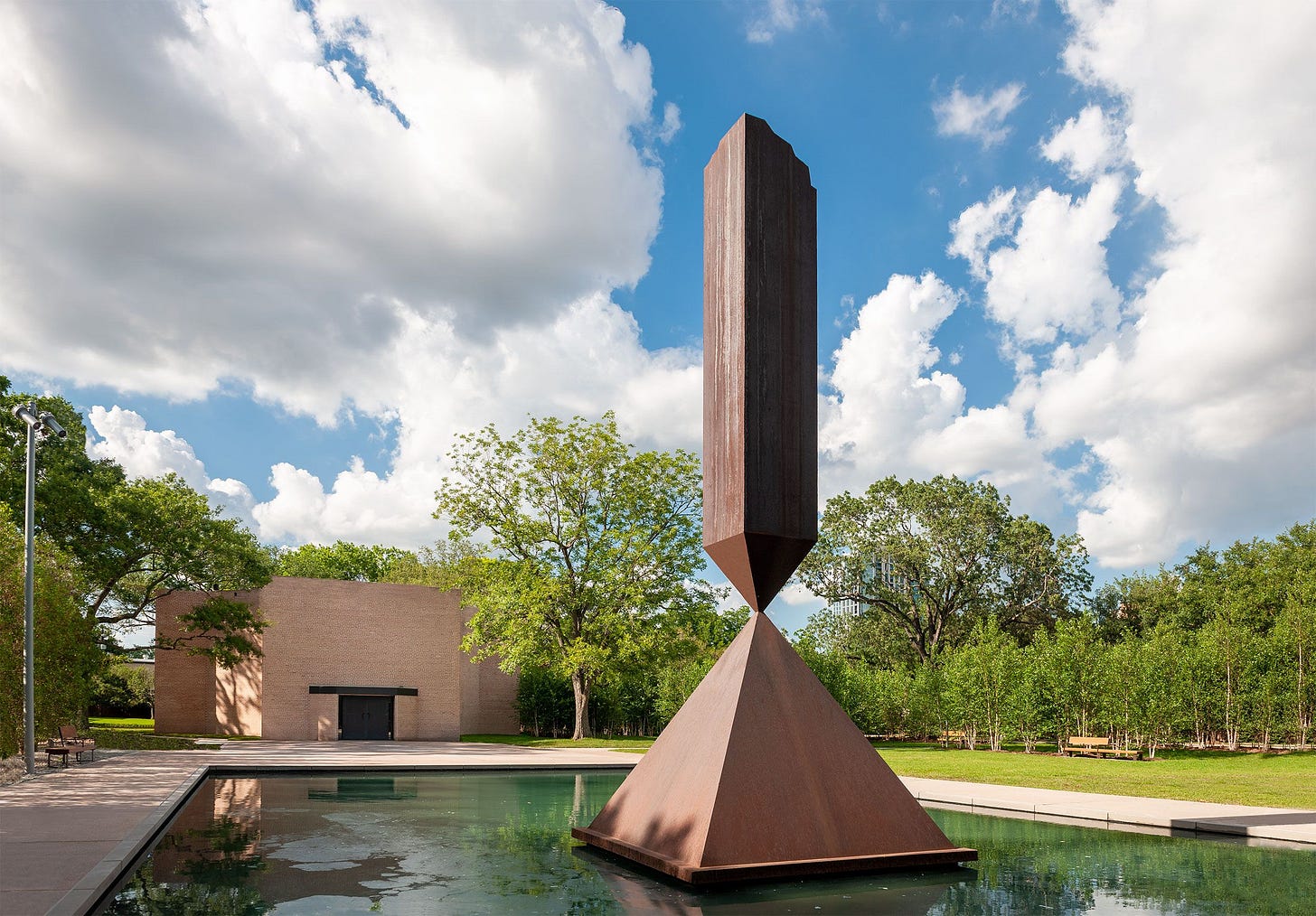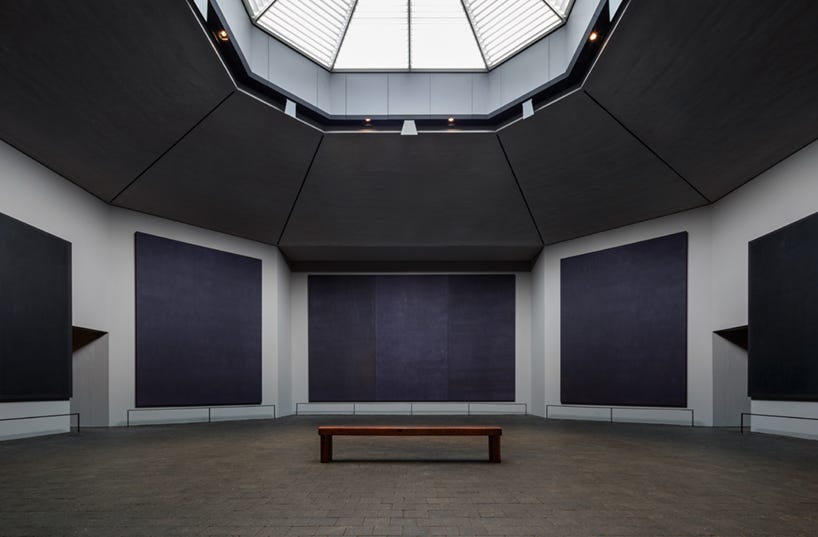Hello internet pals of music. Before I fully sign off of 2021, I’m posting something I’d been working on for paid subscribers when the call of life’s changes came. I’m posting it without any further edits, presenting it as I found it, like a relic or bone dug out of the desert dirt. Some of my descriptions are off. Facts may be need better checking. I surely need an editor. Also, this is a poorly-disguised plug to consider becoming a paid subscriber.
Of the Rothko Chapel, the celebrated American painter’s son, Christopher Rothko, has said “it’s a great place to be alone together”.1
I can attest to this. For the past month I’ve been spending my weekend days there, roughly seven hours a day, as a chapel attendant. I’ve been keeping quiet about this mostly, because upon being hired there is an agreement we sign regarding social media; any posts should be vetted by management first. The reputation of the chapel is very important, and I respect they wouldn’t want to be represented by the same person who is also recommending music like The Devil’s Blood.
Since this is a private channel, however…
The Rothko Chapel is one of my favorite places in Houston. I first visited around 1990, when I was a student at the High School for the Performing and Visual Arts, located a handful of blocks away. I believe my first visit was with an art class, but I’d return several times on my own or with friends over the next few years. My first real crush / love / heartbreak lived across the street from it as well, in one of the many surrounding bungalows, similarly painted what is known as Menil Grey. In fact, the Rothko Chapel stands out from the neighborhood, which includes the bungalows, the Menil Collection, its bistro and bookstore, the Drawing Center and the Cy Twombly Gallery, because it is not grey, at least on the exterior.
It is instead a very nondescript, windowless brick building. And if it were not for the Barnett Newman sculpture Broken Obelisk that sits adjacent its black doors, one might not pay any attention to it.
Image: Paul Hester / Elle Decor
Inside the octagonal chapel, fourteen panel paintings, measuring up to 11’ x 15’, line the walls. There are four single monochromatic paintings that make up the diameter walls (NW, NE, SW, SE) and are a hue closest resembling lavender. On the West and East walls reflecting each other are two matching triptychs that are flat black ringed with what seems like a dark red border but upon closer inspection reveals a strip of texture, maybe raw canvas not treated with gesso. The northern wall, recessed about two and a half feet, holds another triptych, which is large and lavender like the diameter walls. Finally, there is the painting on the southern wall, one which may feel more familiar to Mark Rothko appreciators. It is also a plane of flat black, but in the lower third is a burgundy square with soft edges.
SERMONS! is reader-supported. There are both free and paid subscriptions. If you’re wishing to support my work, I encourage you to become a paid subscriber.
The chapel itself is austere, like the paintings. The walls are grey (Menil Grey, even!), and the floor is a pattern of stone bricks. For seating, there are eight wooden benches that form a ring in the center that mirror the skylight, the chapel’s main source of lighting. In 2019, the chapel closed for a much needed renovation; one of the main changes was this skylight. Rothko had intended the paintings to be seen the way he had painted them, lit overhead naturally like the skylight in his studio. Because Rothko never visited Houston (he took his own life a year prior to the chapel’s completion) and therefore couldn’t account for the effects of the harsh Houston sun would have on the paintings over time, his original skylight plan was a point of contention- original architect Phillip Johnson walked off the project early on because he and Rothko fought over this. The solution ended up being a black baffle that was an attempt to spread the light evenly across the top of the chapel (humorously maligned as “the black spaceship” by some). As a compromise it worked, but the subtlety of the paintings was lost in the darkened atmosphere, unless it was really sunny above. The result of the renovation is a louvered skylight made of UV resistant glass panels, which allows more consistent light in, and a ring of small projectors at the base of the skylight that react to light conditions and kick on when the natural light dims too low for too long. I can vouch, this system is much more interesting and allows the paintings greater depth.
Image: Elizabeth Felicella
The chapel was commissioned by Dominique and John De Menil, whose dedication to civil rights and the arts have had a huge impact on their adopted home of Houston. Originally conceived as an addition to the campus of St. Thomas University, it eventually was re-envisioned as a unique, nondenominational sanctuary. In the vestibule, visitors can find a selection of sacred texts such as The Quran, The Bible, The Tanakh, The Tibetan Book of the Dead, along with books for the Zoroastrian and Ba’hai faiths and several Buddhist texts like The Lotus Sutras. My favorite of the books is a small paperback on the myths and rituals of the Hopi. Guests are invited to bring them into the chapel, and often one can find people there in silent prayer or meditation. In non-Covid times, the chapel hosts weddings, memorials, and meditation services, as well as numerous talks and events related to human rights and other social justice issues. Previous guests have included Nelson Mandela, Bishop Desmond Tutu and the Dalai Lama.
My involvement as of late is as an attendant, which means that I stand quietly in the alcove, dressed head to toe in black. It’s a perfect goth job, as someone pointed out to me. I’m a bit like a guard, ensuring that no one:
Touches the paintings (you’d be surprised at how many people want to do this)
Takes photos (you’d be surprised at how many people immediately leave when they’re told they can’t)
Talks loudly (you’d be surprised that I actually need to do that less than you’d think)
But I’m also there to help when people are confused, agitated or disturbed and to overall guide people through the experience. Because it really is an experience.
When one enters the chapel, they’ll immediately notice how quiet it is. Rothko conceptualized the space as a room for contemplation, and visitors are reminded at the door of this dedication to preserving the sanctity of the space. Depending on the sky, the chapel itself may be light or dark but visitors who spend a reasonable amount of time inside will most assuredly encounter both states. For me, this is most profound, and I get such a reward when I see visitors being affected by the light shifts. For one, the paintings themselves transform. In the light, they have a vibrancy that comes from the various layers of paint washes on the surface (up to twenty layers!). One of my favorite questions I’ve been asked was, “So, you see things in the paintings too, right?” And that answer is, yes. And no, that doesn’t go away or get old. In the large north wall triptych, I consistently see a face, turned to the side and tilted downwards, smiling, as if in mid-laugh. For me, it’s like Gerhard Richter’s blurred photorealistic paintings; features I recognize but my eyes can’t quite hold on to.
But when the sky above changes, perhaps triggered by a passing cloud, the paintings darken. The details become mute, and everything drops a degree in hue, each becoming uniform, dark voids. If one is lucky, they’ll experience a few of these shifts, as the entire mood of the chapel alters. If one can imagine, it transforms the paintings from concrete to static, activating them like time-based media. I always feel a little let down when a guest comes in, takes a quick look then leaves, because I know they’ve missed out. But, I know that’s not everyone’s thought process, and I guess I have to let go of how precious I find those moments and know that there are others who feel and value it the same, and that that should be enough for me, really.
And so often, I’m there pondering simultaneously my own relationship to these paintings as well as that of others. To bring up the Christoper Rothko quote I began with, the chapel is an amazing opportunity to be alone together. My favorite moments aren’t when it’s empty, or when there may be a few guests. The most excited I get is when the chapel has ten people inside, all seated in silence, witnessing each other having a collective but absolutely individual moment. And when another person enters, and without hesitation responds to the energy of the space by immediately taking their spot on the bench, it fills me with an electricity I haven’t been able to define. Another interesting phenomenon is how people in groups will move in unison; for example, after maybe a half hour, a number of unconnected people might suddenly stand up and move together out the door back into the world. It fascinates me and this is when I begin to understand that it’s not some new age babbling to discuss how connected humans actually are. Like a system within the body, we do tend to operate in conjunction or opposition but always in relation to other units of the system.
For me, though, the musical aspect of the chapel has me most curious. The record above (which I’d love to find a copy of) contains the 25 minute, 5 part composition for soprano, alto, mixed choir and instruments commissioned for the opening for the chapel. Numerous other musical events have been held there throughout the years, and the foundation even has a Soundcloud page. Because I know the acoustics, my mind dazzles at the possibilities of sound in the place, all watched over by these fourteen guardians I greet every week.
I know I’ll never get to program my own music night at Rothko. But I can dream. And what I dream is so magical, I’ve decided to make a new playlist for you, so that we can all imagine it together.
https://www.houstoniamag.com/arts-and-culture/2021/02/rothko-chapel-50th-anniversary-celebrations-legacy
SERMONS! is brought to you by Jamie Ward, a multidisciplinary artist currently somewhere in North America. You can also find me on Twitter and Instagram. Like what you’re hearing? Help spread the word!
Musik Klub: “Everythang’s Workin”






